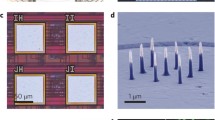Abstract
Microelectrode arrays (MEAs) have enabled investigation of cellular networks at sub-millisecond temporal resolution. However, current MEAs are limited by the large electrode footprint since reducing the electrode's geometric area to sub-cellular dimensions leads to a significant increase in impedance thus affecting its recording capabilities. We report a breakthrough ultra-microelectrodes platform by leveraging the outstanding surface-to-volume ratio of nanowire-templated out-of-plane synthesized three-dimensional fuzzy graphene (NT-3DFG). The enormous surface area of NT-3DFG leads to 140-fold reduction in electrode impedance compared to bare Au microelectrodes, thus enabling scaling down the geometric size by 625-fold to ca. 2 μm × 2 μm. The out-of-plane morphology of NT-3DFG leads to a tight seal with the cell membrane thus enabling recording of electrical signals with high signal-to-noise ratio (SNR) of > 6. This work highlights the possibility to push the limits of the conventional MEA technology to enable electrophysiological investigation at sub-cellular level without the need of any surface coatings. This presented approach would greatly impact our basic understanding of signal transduction within a single cell as well as complex cellular assemblies.

Similar content being viewed by others
References
Thomas, C. A. Jr; Springer, P. A.; Loeb, G. E.; Berwald-Netter, Y.; Okun, L. M. A miniature microelectrode array to monitor the bioelectric activity of cultured cells. Exp. Cell Res.1972, 74, 61–66.
Spira, M. E.; Hai, A. Multi-electrode array technologies for neuroscience and cardiology. Nat. Nanotechnol.2013, 8, 83–94.
Rastogi, S. K.; Kalmykov, A.; Johnson, N.; Cohen-Karni, T. Bioelectronics with nanocarbons. J. Mater. Chem. B2018, 6, 7159–7178.
Deku, F.; Ghazavi, A.; Cogan, S. F. Neural interfaces based on amorphous silicon carbide ultramicroelectrode arrays. Bioelectron. Med.2018, 1, 185–200.
Kozai, T. D. Y.; Langhals, N. B.; Patel, P. R.; Deng, X. P.; Zhang, H. N.; Smith, K. L.; Lahann, J.; Kotov, N. A.; Kipke, D. R. Ultrasmall implantable composite microelectrodes with bioactive surfaces for chronic neural interfaces. Nat. Mater.2012, 11, 1065–1073.
Fu, T. M.; Hong, G. S.; Zhou, T.; Schuhmann, T. G.; Viveros, R. D.; Lieber, C. M. Stable long-term chronic brain mapping at the singleneuron level. Nat. Methods2016, 13, 875–882.
Luan, L.; Wei, X. L.; Zhao, Z. T.; Siegel, J. J.; Potnis, O.; Tuppen, C. A.; Lin, S. Q.; Kazmi, S.; Fowler, R. A.; Holloway, S. et al. Ultraflexible nanoelectronic probes form reliable, glial scar-free neural integration. Sci. Adv.2017, 3, e1601966.
Marblestone, A. H.; Zamft, B. M.; Maguire, Y. G.; Shapiro, M. G.; Cybulski, T. R.; Glaser, J. I.; Amodei, D.; Stranges, P. B.; Kalhor, R.; Dalrymple, D. A. et al. Physical principles for scalable neural recording. Front. Comput. Neurosci.2013, 7, 137.
Maher, M.; Pine, J.; Wright, J.; Tai, Y. C. The neurochip: A new multielectrode device for stimulating and recording from cultured neurons. J. Neurosci. Methods1999, 87, 45–56.
Gabay, T.; Ben-David, M.; Kalifa, I.; Sorkin, R.; Ze’ev, R. A.; Ben-Jacob, E.; Hanein, Y. Electro-chemical and biological properties of carbon nanotube based multi-electrode arrays. Nanotechnology2007, 18, 035201.
Meyer, R. D.; Cogan, S. F.; Nguyen, T. H.; Rauh, R. D. Electrodeposited iridium oxide for neural stimulation and recording electrodes. IEEE Trans. Neural Syst. Rehabil. Eng.2001, 9, 2–11.
Cui, X. Y.; Lee, V. A.; Raphael, Y.; Wiler, J. A.; Hetke, J. F.; Anderson, D. J.; Martin, D. C. Surface modification of neural recording electrodes with conducting polymer/biomolecule blends. J. Biomed. Mater. Res.2001, 56, 261–272.
Scanziani, M.; Häusser, M. Electrophysiology in the age of light. Nature2009, 461, 930–939.
Cogan, S. F.; Guzelian, A. A.; Agnew, W. F.; Yuen, T. G.; McCreery, D. B. Over-pulsing degrades activated iridium oxide films used for intracortical neural stimulation. J. Neurosci. Methods2004, 137, 141–150.
Lu, Y. C.; Lyu, H.; Richardson, A. G.; Lucas, T. H.; Kuzum, D. Flexible neural electrode array based-on porous graphene for cortical microstimulation and sensing. Sci. Rep.2016, 6, 33526.
Rastogi, S. K.; Bliley, J.; Shiwarski, D. J.; Raghavan, G.; Feinberg, A. W.; Cohen-Karni, T. Graphene microelectrode arrays for electrical and optical measurements of human stem cell-derived cardiomyocytes. Cell. Mol. Bioeng.2018, 11, 407–418.
Garg, R.; Rastogi, S. K.; Lamparski, M.; de la Barrera, S. C.; Pace, G. T.; Nuhfer, N. T.; Hunt, B. M.; Meunier, V.; Cohen- Karni, T. Nanowire-mesh-templated growth of out-of-plane three-dimensional fuzzy graphene. ACS Nano2017, 11, 6301–6311.
Chen, G. K.; Gulbranson, D. R.; Hou, Z. G.; Bolin, J. M.; Ruotti, V.; Probasco, M. D.; Smuga-Otto, K.; Howden, S. E.; Diol, N. R.; Propson, N. E. et al. Chemically defined conditions for human iPSC derivation and culture. Nat. Methods2011, 8, 424–429.
Lian, X. J.; Zhang, J. H.; Azarin, S. M.; Zhu, K. X.; Hazeltine, L. B.; Bao, X. P.; Hsiao, C.; Kamp, T. J.; Palecek, S. P. Directed cardiomyocyte differentiation from human pluripotent stem cells by modulating Wnt/ß-catenin signaling under fully defined conditions. Nat. Protoc.2013, 8, 162–175.
Burridge, P. W.; Matsa, E.; Shukla, P.; Lin, Z. C.; Churko, J. M.; Ebert, A. D.; Lan, F.; Diecke, S.; Huber, B.; Mordwinkin, N. M. et al. Chemically defined generation of human cardiomyocytes. Nat. Methods2014, 11, 855–860.
Tohyama, S.; Hattori, F.; Sano, M.; Hishiki, T.; Nagahata, Y.; Matsuura, T.; Hashimoto, H.; Suzuki, T.; Yamashita, H.; Satoh, Y. et al. Distinct metabolic flow enables large-scale purification of mouse and human pluripotent stem cell-derived cardiomyocytes. Cell Stem Cell2013, 12, 127–137.
Rastogi, S. K.; Raghavan, G.; Yang, G.; Cohen-Karni, T. Effect of graphene on nonneuronal and neuronal cell viability and stress. Nano Lett.2017, 17, 3297–3301.
Kovács, M.; Tóth, J.; Hetényi, C.; Málnási-Csizmadia, A.; Sellers, J. R. Mechanism of blebbistatin inhibition of myosin II. J. Biol. Chem.2004, 279, 35557–35563.
Li, X.; Matino, L.; Zhang, W.; Klausen, L.; McGuire, A. F.; Lubrano, C.; Zhao, W. T.; Santoro, F.; Cui, B. X. A nanostructure platform for live-cell manipulation of membrane curvature. Nat. Protoc.2019, 14, 1772–1802.
Santoro, F.; Zhao, W. T.; Joubert, L. M.; Duan, L. T.; Schnitker, J.; van de Burgt, Y.; Lou, H. Y.; Liu, B. F.; Salleo, A.; Cui, L. F. et al. Revealing the cell-material interface with nanometer resolution by focused ion beam/scanning electron microscopy. ACS Nano2017, 11, 8320–8328.
Smith, S. W. The Scientist and Engineer’s Guide to Digital Signal Processing; California Technical Pub: California, 1997.
Noda, T.; Noda, Y.; Chen, P. C.; Haruta, M.; Sasagawa, K.; Tokuda, T.; Wu, C. Y.; Ohta, J. Electrochemical evaluation of geometrical effect and three-dimensionalized effect of iridium oxide electrodes used for retinal stimulation. Sens. Mater.2018, 30, 213–224.
Weiland, J. D.; Anderson, D. J.; Humayun, M. S. In vitro electrical properties for iridium oxide versus titanium nitride stimulating electrodes. IEEE Trans. Biomed. Eng.2002, 49, 1574–1579.
Cogan, S. F. Neural stimulation and recording electrodes. Annu. Rev. Biomed. Eng.2008, 10, 275–309.
Rastogi, S. K.; Cohen-Karni, T. Nanoelectronics for neuroscience. In Encyclopedia of Biomedical Engineering. Narayan, R.; Elsevier: Amsterdam, 2019.
Kuzum, D.; Takano, H.; Shim, E.; Reed, J. C.; Juul, H.; Richardson, A. G.; de Vries, J.; Bink, H.; Dichter, M. A.; Lucas, T. H. et al. Transparent and flexible low noise graphene electrodes for simultaneous electrophysiology and neuroimaging. Nat. Commun.2014, 5, 5259.
Ganji, M.; Kaestner, E.; Hermiz, J.; Rogers, N.; Tanaka, A.; Cleary, D.; Lee, S. H.; Snider, J.; Halgren, M.; Cosgrove, G. R. et al. Development and translation of PEDOT: PSS microelectrodes for intraoperative monitoring. Adv. Funct. Mater.2018, 28, 1700232.
Navarrete, E. G.; Liang, P.; Lan, F.; Sanchez-Freire, V.; Simmons, C.; Gong, T. Y.; Sharma, A.; Burridge, P. W.; Patlolla, B.; Lee, A. S. et al. Screening drug-induced arrhythmia using human induced pluripotent stem cell-derived cardiomyocytes and low-impedance microelectrode arrays. Circulation2013, 128, S3–S13.
Yang, X.; Zhou, T.; Zwang, T. J.; Hong, G. S.; Zhao, Y. L.; Viveros, R. D.; Fu, T. M.; Gao, T.; Lieber, C. M. Bioinspired neuron-like electronics. Nat. Mater.2019, 18, 510–517.
Xie, C.; Liu, J.; Fu, T. M.; Dai, X. C.; Zhou, W.; Lieber, C. M. Three-dimensional macroporous nanoelectronic networks as minimally invasive brain probes. Nat. Mater.2015, 14, 1286–1292.
Viswam, V.; Obien, M. E. J.; Franke, F.; Frey, U.; Hierlemann, A. Optimal electrode size for multi-scale extracellular-potential recording from neuronal assemblies. Front. Neurosci.2019, 13, 385.
Perry, S. W.; Norman, J. P.; Barbieri, J.; Brown, E. B.; Gelbard, H. A. Mitochondrial membrane potential probes and the proton gradient: A practical usage guide. Biotechniques2011, 50, 98–115.
Kroemer, G.; Galluzzi, L.; Brenner, C. Mitochondrial membrane permeabilization in cell death. Physiol. Rev.2007, 87, 99–163.
Karbowski, M.; Youle, R. J. Dynamics of mitochondrial morphology in healthy cells and during apoptosis. Cell Death Differ.2003, 10, 870–880.
Hai, A.; Dormann, A.; Shappir, J.; Yitzchaik, S.; Bartic, C.; Borghs, G.; Langedijk, J. P. M.; Spira, M. E. Spine-shaped gold protrusions improve the adherence and electrical coupling of neurons with the surface of micro-electronic devices. J. R. Soc. Interface2009, 6, 1153–1165.
Dipalo, M.; McGuire, A. F.; Lou, H. Y.; Caprettini, V.; Melle, G.; Bruno, G.; Lubrano, C.; Matino, L.; Li, X.; De Angelis, F. et al. Cells adhering to 3D vertical nanostructures: Cell membrane reshaping without stable internalization. Nano Lett.2018, 18, 6100–6105.
Clements, M.; Thomas, N. High-throughput multi-parameter profiling of electrophysiological drug effects in human embryonic stem cell derived cardiomyocytes using multi-electrode arrays. Toxicol. Sci.2014, 140, 445–461.
Cohen-Karni, T.; Casanova, D.; Cahoon, J. F.; Qing, Q.; Bell, D. C.; Lieber, C. M. Synthetically encoded ultrashort-channel nanowire transistors for fast, pointlike cellular signal detection. Nano Lett.2012, 12, 2639–2644.
Cohen-Karni, T.; Qing, Q.; Li, Q.; Fang, Y.; Lieber, C. M. Graphene and nanowire transistors for cellular interfaces and electrical recording. Nano Lett.2010, 10, 1098–1102.
Acknowledgements
T. C.-K. acknowledges funding support from the National Science Foundation under Award No. CBET1552833 and the Office of Naval Research under Award No. N000141712368. J. B. and A. W. F. acknowledge financial support from the Dowd Fellowship from the College of Engineering at Carnegie Mellon University. L. M. and F. S. acknowledge Valentina Mollo for ssthe preparation of SEM/FIB samples. We also acknowledge support from the Department of Materials Science and Engineering Materials Characterization Facility (MCF-677785).
Author information
Authors and Affiliations
Corresponding author
Electronic Supplementary Material
Rights and permissions
About this article
Cite this article
Rastogi, S.K., Bliley, J., Matino, L. et al. Three-dimensional fuzzy graphene ultra-microelectrodes for subcellular electrical recordings. Nano Res. 13, 1444–1452 (2020). https://doi.org/10.1007/s12274-020-2695-y
Received:
Revised:
Accepted:
Published:
Issue Date:
DOI: https://doi.org/10.1007/s12274-020-2695-y




